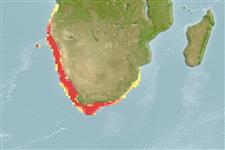Environment: milieu / climate zone / depth range / distribution range
Ecologie
marien bathydemersaal; oceanodroom (Ref. 51243); diepte 50 - 1000 m (Ref. 27121), usually 150 - 450 m (Ref. 27121). Deep-water; 11°S - 37°S, 5°E - 33°E (Ref. 58452)
Southeast Atlantic: Baie Farte, Angola around Cape to Natal, South Africa. Also found on Valdivia Bank (26°18'S, 6°20'E).
Lengte bij maturiteit / Grootte / Gewicht / Leeftijd
Maturity: Lm 47.4 range ? - ? cm
Max length : 140 cm TL mannelijk / geslacht onbekend; (Ref. 6605); common length : 50.0 cm TL mannelijk / geslacht onbekend; (Ref. 1371)
Dorsale stekels (totaal) : 1; Dorsale zachte stralen (totaal) : 47 - 54; Anale stekels: 0; Anale zachte stralen: 37 - 41. Light brown above, silvery to white below (Ref. 6605).
Found on the continental shelf and slope to depths over 1,000 m (Ref. 27121). Juveniles (to about 64 cm) feed on small crustaceans and small deep-sea fishes such as lanternfishes, whereas larger individuals feed chiefly on small hakes and jack mackerel (Ref. 1371); cannibalism is common (Ref. 27121). Migrates southward in the spring and northward in autumn (Ref. 1371). Breeds throughout the year, peaks of reproductive activity in August and September (Ref. 36731). Marketed smoked, frozen, and fresh on ice; eaten steamed, fried and baked (Ref. 9988).
Levenscyclus en paargedrag
Maturities | Voortplanting | Spawnings | Egg(s) | Fecundities | Larven
Cohen, D.M., T. Inada, T. Iwamoto and N. Scialabba, 1990. FAO species catalogue. Vol. 10. Gadiform fishes of the world (Order Gadiformes). An annotated and illustrated catalogue of cods, hakes, grenadiers and other gadiform fishes known to date. FAO Fish. Synop. 125(10). Rome: FAO. 442 p. (Ref. 1371)
Status op de Rode Lijst van het IUCN (Ref. 130435)
Gevaar voor de mens
Harmless
Gebruik door de mens
Visserij: van minder commercieel belang
Tools
Speciale rapporten
Download XML
Internetbronnen
Estimates based on models
Preferred temperature (Ref.
123201): 7.7 - 14.4, mean 10.2 °C (based on 78 cells).
Fylogenetische diversiteitsindex (Ref.
82804): PD
50 = 0.5000 [Uniqueness, from 0.5 = low to 2.0 = high].
Bayesian length-weight: a=0.00513 (0.00340 - 0.00773), b=3.11 (2.98 - 3.24), in cm total length, based on LWR estimates for this species & Genus-body shape (Ref.
93245).
Trofisch niveau (Ref.
69278): 3.9 ±0.65 se; based on food items.
Generation time: 9.2 (7.9 - 12.1) years. Estimated as median ln(3)/K based on 21
growth studies.
Weerstandsvermogen (Ref.
120179): laag, minimale populatieverdubbelingstijd 4,5-14 jaar (K=0.07-0.13).
Fishing Vulnerability (Ref.
59153): High to very high vulnerability (67 of 100).
Climate Vulnerability (Ref.
125649): Very high vulnerability (86 of 100).
Nutrients (Ref.
124155): Calcium = 6.55 [3.45, 22.85] mg/100g; Iron = 0.282 [0.055, 0.771] mg/100g; Protein = 16.8 [15.7, 18.1] %; Omega3 = 0.123 [0.066, 0.231] g/100g; Selenium = 32.1 [14.4, 77.4] μg/100g; VitaminA = 9.09 [1.90, 42.59] μg/100g; Zinc = 0.225 [0.151, 0.358] mg/100g (wet weight);
